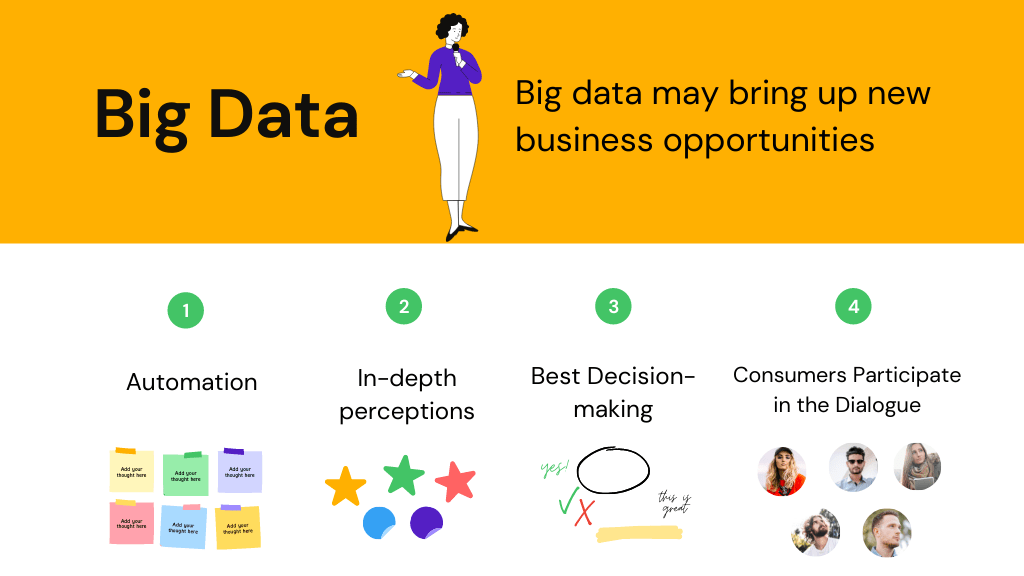The phrase big data has been a favourite among business professionals for many years; yet, despite the term’s increasing popularity in 2014, many people were already sick of hearing it. Deloitte, for example, advocated that the term should simply not be used anymore. Despite this, there is an enormous financial potential hidden behind the keyword, which many organizations are just now beginning to realize.
Big data is a term that refers to massive collections of unstructured, semi-structured, or organized data that have been gathered from a variety of sources. Some examples of data sources are consumer databases, medical records, commercial transaction systems, social media platforms, mobile apps, and scientific research, among others.
Nowadays, businesses are concentrating on revamping their data architecture, unifying data, and removing obsolete software from their systems. Big data has a significant influence on organizations because it enables them to handle massive amounts of data in an efficient manner.
Big data is a term that characterizes enormous, complicated datasets that are often derived from a range of sources. A decade ago, the vast majority of them were internal data sources, such as customer relationship management systems (CRMs), website surfing activity, invoicing, and accounting system logs. As data science becomes more prevalent, external or alternative sources of data are becoming more important since they may give new information that might not otherwise be collected in-house. By 2025, the global market for big data is estimated to reach USD 123.23 billion.
For successful organizations, the ability to use and interpret large amounts of data is a critical competitive edge. Big Data consulting services companies’ ability to gather more data from current infrastructure and customers will provide them with the potential to uncover previously undiscovered insights that their rivals do not have access to.
Big data may bring up new business opportunities
Big data may open up a plethora of new business options, ranging from internal insights to front-facing consumer interactions and everything in between. Automation, in-depth analytics, and data-driven decision-making process are three of the most significant business prospects available today.
- Automation
Internal efficiency and operations can be improved by robotic process automation, which can be achieved using big data. Massive volumes of real-time data can be examined instantaneously and integrated into corporate processes to enable automated decision-making to take place. Automation of data gathering and storage is now possible because of scalable IT infrastructure and declining cloud computing prices.
- In-depth perceptions
Big data may also be used to uncover previously undiscovered possibilities that were previously unavailable to businesses due to the inability to evaluate vast amounts of data. The utilization of complex data sets may also be utilized to generate new products or improve the functionality of current ones. Market-specific proprietary data may be very important in the context of a competitive environment.
- Best Decision-making
The rapidity with which data analytics technology is evolving, along with the capability of analyzing new data sources, has enabled organizations to evaluate information in real-time and make smart, educated business choices.
- Consumers Participate in the Dialogue
Nowadays, customers like to study and compare products on many review websites as well as social media channels before making their purchasing choice. Big Data allows commercial organizations to participate in one-on-one and real-time dialogues with customers via the use of data analytics. It is also advantageous in terms of merging the digital and real purchasing worlds.
In a sense, big data embodies the golden rule of current artificial intelligence: the more data you have, the more accurate your forecasts are. Despite the fact that the advantages of big data are many, we should focus on the three most essential ones that drive the bulk of big data investment.
- Quality
Modern businesses are always looking for ways to gain a competitive edge, and big data may assist with better, more accurate target marketing via enhanced data analytics and better decision-making. It provides suggestions on methods to improve the overall quality of goods and services. Big data makes monetization easier by offering a more complete insight of the demands of the customers. It facilitates the adoption of a more tailored and targeted approach, as well as the reduction of time and the improvement of the efficiency of corporate operations. Overall, the use of big data resulted in higher-quality goods, improved customer experiences, and increased client happiness, according to the data.
- Cost Data-driven AI
Cost Data-driven AI initiatives are often built with the purpose of gaining the advantages of workflow automation. By delegating repetitive and routine duties to robots, human professionals are free to devote their time and energy to more value-adding business objectives. Big data assists in the discovery of new cost-cutting opportunities by increasing the efficiency of current business operations. This increases time management while also enhancing the pace with which products reach the market. When combined with high-quality data, big data paves the way for companies to generate more profits and achieve long-term economic success.
- Analytics
This is where the section on making better forecasts comes into play. Big data enables you to observe more than just a trend inside an industry or a process that you are interested in. And when we say’s,’ we mean it literally: data visualization is one of the benefits that can only be obtained via the use of large amounts of data. It provides a more comprehensive picture and, guided by a broader range of connections and patterns, assists you in answering the most fundamental question: why something occurs in the manner that it does. Big data provides context by displaying data that is always in motion, 24 hours a day, seven days a week. It paves the path for better decision-making since big data delivers insights into previously undiscovered patterns. As a result, big data is increasingly being utilized by enterprises for predictive analysis and the formulation of well-informed judgments that are weighted.
Big data in the era of Covid-19
The new coronavirus, which has caused a considerable number of active cases throughout the world, constitutes a serious public health threat. Travel restrictions have been imposed as a result of the emergence of the pandemic, making data collecting a difficult undertaking for the development research community.
It is possible that traditional means of data collecting, such as field trips, will be dangerous during these periods. Taking this into consideration, provided adequate privacy and ethical controls are in place, big data is both important and beneficial, maybe more so than ever before. More than a year after the outbreak, the global community is still struggling to contain the COVID-19 pandemic. While the majority of people have become used to the new normal, new cases and novel coronavirus variations are still being reported in various parts of the world. Lockdowns and commercial interruptions have also had a negative influence on the world economy, which is currently suffering from the consequences.
COVID-19 and big data are intertwined.
Because of the exponential increase in the number of coronavirus infections, big data has the potential to aid in the detection of outbreaks of the disease. When we combine information from various sources, we may use algorithms to analyze health records and track the contact history of patients in order to better understand viral dissemination patterns. However, despite privacy concerns, big data has a bright future in the healthcare industry. As travel restrictions remain in place in many countries, it is possible that chances for leveraging big data to compensate for the absence of in-person data collecting will increase in number.
Using Big Data to Identify and Address Problems
- The use of big data analytics and artificial intelligence technologies has been critical in the study of the coronavirus and the development of remedies for its detection and care. Massive and uncontrolled data are continuously analyzed in order to uncover patterns and major changes, which are crucial in the development of strategies for successful pandemic response and preparedness.
- One particular use of big data analytics and artificial intelligence is in the field of epidemiological modeling. It is possible to track virus transmission networks with greater precision. Data on individual mobility may be utilized to simulate the propagation of a virus on a more detailed level using individual movement data. Monitoring becomes more effective, and contact rate estimations become more accurate as a result of these improvements.
- Big data is also useful in the identification of novel variations as well as the determination of their distinctions. In computed tomography, patient data, and test results, it may help spot abnormalities and recognize patterns that might otherwise go undetected. The data is also useful in presenting an overall good pic of how the epidemic is affecting corporate operations and international trade and economics.
Conclusion
Big data impact on businesses has reached a higher level. In today’s digital age, data-driven decision-making is increasingly becoming the standard practice. Because data gathering and analysis are more accessible than ever before, organizations large and small are making use of this technology – and experiencing great outcomes as a consequence of their efforts. When you have a large amount of data, it may be difficult to extract significant insights from it. This is especially true when you have “big data.”
Businesses get a new competitive advantage as a result of big data. It is advantageous to corporate organizations in both the commercial and governmental sectors in a variety of different ways. It helps commercial enterprises to take advantage of data while also identifying the most important clients. This approach, it contributes significantly to the development of new services, products, and experiences by enterprises.







